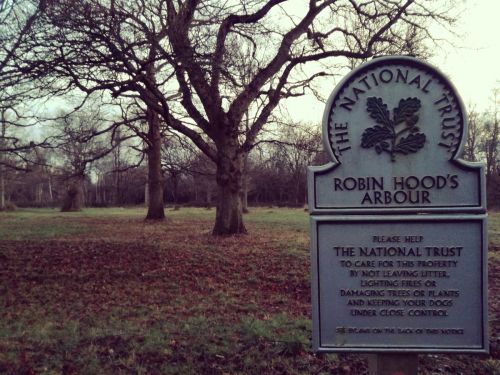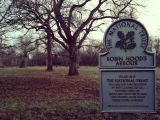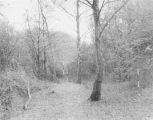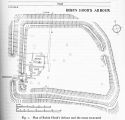Robin Hood's Arbour (Maidenhead)
| Locality | |
|---|---|
| Coordinate | 51.522123, -0.773294 |
| Adm. div. | Berkshire |
| Vicinity | In Maidenhead Thicket |
| Type | Prehistoric site |
| Interest | Robin Hood name |
| Status | Extant |
| First Record | c. 1690 |
| A.k.a. | Robin Hood's Bower |

By Henrik Thiil Nielsen, 2017-12-20. Revised by Henrik Thiil Nielsen, 2021-03-21.
Robin Hood's Arbour is a square prehistoric earthwork in Maidenhead Thicket, which by the late 17th century was known as 'Robin Hood's Bower', an alternative name still in use today.
Bannard described the location as follows in 1931: "It is close against the private road that runs from the Henley road to Stubbings House. It is in sight of the Lodge and about 300 yards south-east of it. It is in the angle of the road to Stubbings and the grass track which crosses it, and is barely 30 yards south of the latter".[1] The site was first discussed by Charles Kerry (1861), who concluded from what he considered its "well-known features of Roman castramentation" that Robin Hood's Arbour was of Roman construction, an idea that persisted well into the 20th century.[2] Mrs M. Cotton Aylwin, who made the first modern archaeological excavation of the site in 1961, describes the 'arbour' as a sub-rectangular "ditched rectilinear enclosure". Its shape, which can be seen on the plan in the image gallery at the foot of this page, is not unlike that of the handles of some modern coffee cups and mugs. Its outer dimensions are approximately – clockwise from the north – 44 m, 64 m, 70 m, and 47.5 m. There is an inner bank along all sides except the southern, a ditch of variable width and depth along all sides and, except to the north, where it may however once have existed, a counterscarp bank. The banks have been breached in several places, but this may be explained as the scars of previous excavations. Only on the western side is there an original entrance along a causeway over the ditch. It has been suggested 'on grounds of contiguity and contemporaneity' that another earthwork in the immediate vicinity is associated with Robin Hood's Arbour.[3]
Robbers in Maidenhead thicket
As Dobson & Taylor noted, the existence of this place-name in the late 17th century was probably the reason Thomas Hearne (see Allusions on this page) included the Chiltern Hills among Robin's haunts.[4] Conversely, it also seems likely that the character (and history) of this area made it seem a fit haunt for a famous robber and one where interesting localities such as the 'arbour' might well come to be named after such a character. While it was evidently safe enough for boys like the young Thomas Hearne to roam in the late 17th century, Maidenhead Thicket had been infested with robbers in earlier centuries. In 1255, under Henry III, an order was issued to widen the road between Maidenhead Bridge and Henley-on-Thames and cut down vegetation along it in order to make the route safer for travellers. As late as the reign of Elizabeth, legislation suggests that the problem persisted, and in this period the vicar of Hurley, who also served the parish of Maidenhead, was allegedly granted an increase of salary in view of the risk he ran passing through the Thicket en route from one parish to the other. Leland around the middle of the 16th century had no doubt that Maidenhead Thicket was infested with robbers.[5] While I see no reason to take seriously Hearne's curious idea that the robbers were once-decent people who had taken to highway robbery after bankrupting themselves financing their fancy flint houses with high-interest loans, it is quite possible that a lingering memory of highwaymen and danger made this area seem a fitting one for R. Hood. On the other hand, if this was the case, it has left no other trace. Bannard noted in 1931 that the earthwork was "known for some unfathomable reason, as Robin Hood's Arbour, though there is no trace in record or legend of Robin Hood ever having frequented the Thicket".[1]
Imaginary dancers in the Thicket?
Margaret Gelling may thus well be right in characterizing Robin Hood's Arbour as "a fanciful name applied to a prehistoric earthwork",[6] but it is also possible that the name was based on simple analogy. My case would be better if I could find the reference or remember the name of the source, but I will have to rely on memory (such as it is). I read many years ago a description of how an area was prepared as a dancing ground by having the turf and the top few tens of centimeters of soil removed to form a shallow, square hole with an even floor, the excavated soil and the turves being used to construct a seating arrangement round the perimeter of the excavated area; the boy scout version of a sofa, as it were. I believe the account referred to 19th century practice, but I do not recollect whether it referred to a locality in Britain or Scandinavia. However, if the arbours and bowers used for spring and summer festivals in England were at least sometimes made like this more recent open-air 'dance hall', perhaps the element "bower" or 'arbour' in the name of this Maidenhead locality was introduced by simple visual analogy? William Denne's The Shepheards' Holiday (1651) mentions a feast "vpon this ide of May", in a "Sheepheards bower" with a "garnisht cloath [...] spread [...] on the turfie table".[7] If the latter does not simply refer to the ground, Denne may have had a similar arrangement in mind. I have suggested an equally obvious visual analogy as the motivation for the name Robin Hood's Butts.
Since the Thames Valley is one of the hotspots of historical Robin Hood game activity, one might even be tempted to speculate that Robin Hood's Arbour may owe its name to having actually been used as the venue for spring or summer festivals. The Thicket may have been a dangerous place for a solitary traveller, but this would not necessarily have been the case for a crowd of people. Was it too remote to serve as a venue for such occasions? Kerry noted that "the thicket has never been cultivated, and [...] until comparatively modern times there were but few habitations in the locality",[8] but on the other hand we may note that it was evidently close enough to "habitations" for boys like the young Mr Hearne to roam in the late 17th century. By 1961, "the site had become so overgrown that it was only partly visible, and some clearance and preservation of the surface features seemed desirable".[9] Yet the site, 'never' cultivated according to Kerry, was clearly visible when Hearne was a boy and it must have been so at the time when it acquired the name "Robin Hood's Bower" (or Arbour), for an unremarkable rectangular area in a thicket would hardly attract enough attention for anyone to need a name for it. Was the vegetation kept in check because the site was used as a festival venue? Inside the 'arbour', above the Belgic and neolithic[10] – pace Kerry, not Roman – pot shards, the 1961 excavation found modern pottery and two clay-pipes, one of them dating from the 1640s to 1660s.[11] On the other hand, the 'arbour' was located close to a minor road, so perhaps it remained visible due to efforts to keep vegetation low along the route, and Hearne obviously has nothing to say about spring festivals at the site. The naming-by-analogy hypothesis makes fewer assumptions, so we should stick with it.
A few mistakes and a map
Crawford in 1924 listed Robin Hood's Arbour among names containing the element "harbour", as found in the mysterious but not rare field name Cold Harbour.[12] Given the well-documented connection of the Robin Hood figure with spring and summer festivals and the use of arbours (or bowers) in this festive context, and in view of the absence of early forms or other evidence to connect 'Arbour' with 'harbour' in this specific case, such a connection should not be posited as the sole explanation.
According to Margaret Gelling, "Mrs Cotton notes that the name [of Robin Hood's Arbour] is first recorded in 1861".[6] What Mrs Cotton, the archaeologist, states is that "[t]he earliest reference to the site traced is that of Kerry in 1861".[13] To an archaeologist a place-name and the place to which it refers are no more the same thing than they should be to a place-name researcher. The place-name, as we have seen, is a good deal older than 1861. The earliest of the O.S. maps available online to include the name of the 'arbour' is an 25" map reissued in 1912, but the name may well be included in two earlier issues of the map dating from 1876 and 1899 (see Maps below).Allusions
1733 - Hearne, Thomas - Note in Chronicon Prioratus de Dunstaple
[Joseph Ritson's translation:]
Certainly Silchester, in Hampshire, signifies nothing but the city of flints (that is, a city composed or built of flint-stones). [. . .] And what is more, in that very Chiltern country you may frequently see houses built of flints, in erecting which, in ancient times, I suppose that many persons involved themselves deeply in debt, and that, in order to extricate themselves, they took up money at interest of I know not what great men, which so far disturbed their minds that they would become thieves, and do many things in no wise agreeable to the English government. Hence, the nobility ordered that large woods in the Chiltern country should, in a great measure, be cut down, lest they should conceal any considerable body of robbers, who were wont to convert the same into lurking places. [. . .] It concerns this matter to call to mind, that of this sort of robbers was that Robin or Robert Hood, of whom the vulgar dayly [sic] sing so many wonderful things. He (being now made an outlaw) before he retired into the north parts, frequently robing [sic] in the Chiltern country, linked[14] [sic] in the thickets thereof on purpose that he should not be taken. Thence it was, that to us boys, (exhilarating, according to custom, the mind with sports) certain countrymen, with whom we [vol. I, p. cii n.:] had accidentally some conversation, shewed us that sort of den or retreat (vulgarly called Robin Hoods bower) in Maydenhead-thicket: which thicket is the same that Leland in his Itinerary, called Frith, by which name the Anglo-Saxons themselves spoke of thickets. For although frið in reality signifys [sic] peace, yet since numerous groves with them (as well as before with the Britons) were deemed sacred, it is by no means to be wondered at that a great wood (because manifestly an asylum) should in the judgment of the Anglo-Saxons be called by no other name than friðer: [sic] and that Maydenhead-thicket was esteemed among the greater woods Leland himself is a witness. Rightly therefor [sic] did Robin Hood (as frið-bena) reckon himself to abide there in security.[15]
Gazetteers
- Dobson, R. B., ed.; Taylor, J., ed. Rymes of Robyn Hood: an Introduction to the English Outlaw (London, 1976), p. 295, s.n. Robin Hood's Arbour.
Maps
- 25" O.S. map Berkshire XXIV.13 (c. 1876; surveyed 1874). No copy in NLS
- 25" O.S. map Berkshire XXIV.13 (c. 1899; rev. c. 1897). No copy in NLS
- 25" O.S. map Berkshire XXIV.13 (1912; rev. 1910)
- 25" O.S. map Berkshire XXIV.13 (1912; rev. 1910) (georeferenced)
- 25" O.S. map Berkshire XXIV.13 (1925; rev. 1923)
- 25" O.S. map Berkshire XXIV.13 (1934; rev. 1932)
- 6" O.S. map Berkshire XXIV (1882; surveyed 1875)
- 6" O.S. map Berkshire XXIV.SW (1900; rev. 1897)
- 6" O.S. map Berkshire XXIV.SW (1900; rev. 1897) (georeferenced)
- 6" O.S. map Berkshire XXIV.SW (1913; rev. 1910)
- 6" O.S. map Berkshire XXIV.SW (1926; rev. 1923)
- 6" O.S. map Berkshire XXIV.SW (1931; rev. 1931-32)
- 6" O.S. map Berkshire XXIV.SW (c. 1944; rev. 1938).
Sources
- Gelling, Margaret. The Place-Names of Berkshire (English Place-Name Society, vols. XLIX-LI) (Cambridge, 1973; [s.l.], 1974-76), pt. I, p. 57, and see pt. I, p. 285
Discussion
- Anonymous. '[Untitled letter to the editor]', Gentleman's Magazine, vol. XXXVI (1766), p. 400
- Bannard, H. E. 'Maidenhead Thicket', The Berkshire Archæological Journal, vol. 35, No. 1 (1931), pp. 63-80
- Bowden, Mark; Ford, Steve; Gaffney, Vince. 'Excavation of an Earthwork on Maidenhead Thicket, 1982', Berkshire Archæological Journal, vol. 71 (1982), pp. 21-31; see p. 26
- Cotton, M. Aylwin; [Cornwall, I.W., contrib.] 'Robin Hood's Arbour and Rectilinear Enclosures in Berkshire', Berkshire Archaeological Journal, vol. 59 (1961), pp. 1-35
- Crawford, O. G. S. 'Place-Names and Archaeology', chapter VIII in: Mawer, A.; Stenton, F.M. Introduction to the Survey of English Place-Names (English Place-Name Society, vol. I, pt. 1). (Cambridge, 1924), pp. 143-64; see p. 163
- Crawford, O. G. S. 'Place-Names and Archaeology', chapter VIII in: Mawer, A.; Stenton, F.M. Introduction to the Survey of English Place-Names (English Place-Name Society, vol. I, pt. 1). (Cambridge, 1925), pp. 143-64; see p. 163
- Crawford, O. G. S. 'Place-Names and Archaeology', chapter VIII in: Mawer, A.; Stenton, F.M. Introduction to the Survey of English Place-Names (English Place-Name Society, vol. I, pt. 1). Reprinted. (Cambridge, 1929), pp. 143-64; see p. 163
- Crawford, O. G. S. 'Place-Names and Archaeology', chapter VIII in: Mawer, A.; Stenton, F.M. Introduction to the Survey of English Place-Names (English Place-Name Society, vol. I, pt. 1). Reprinted. (Cambridge, 1933), pp. 143-64; see p. 163
- Crawford, O. G. S. 'Place-Names and Archaeology', chapter VIII in: Mawer, A.; Stenton, F.M.; Gover, J.E.B. The Place-Names of Sussex (English Place-Name Society, vols. VI-VII) (Cambridge, 1969), pp. 143-64; see p. 163
- Editor. 'Earthworks in Berks, Bucks and Oxon', The Berks, Bucks & Oxon Archæological Journal, New Series, vol. 7, No. 1 (1901), pp. 95-96
- Ditchfield, P.H., ed.; Page, William, ed. & gen. ed. The Victoria History of Berkshire. Vol. I (The Victoria History of the Counties of England) ([London], 1906, p. 204
- Kerry, Charles. The History and Antiquities of the Hundred of Bray, in the County of Berks (London, 1861), pp. 146-47, 150
- Peake, Harold. The Archaeology of Berkshire (London, [1931]), pp. 97, 190.
Background
- Historic England
- The Megalithic Portal: Robin Hood's Arbour
- National Trust: Maidenhead Thicket - Maidenhead Common
- Wikipedia: Belgae
- Wikipedia: Pinkneys Green.
Also see
Notes
- ↑ 1.0 1.1 Bannard, H. E. 'Maidenhead Thicket', The Berkshire Archæological Journal, vol. 35, No. 1 (1931), pp. 63-80; see p. 65.
- ↑ Cotton, M Aylwin; [Cornwall, I.W., contrib.] 'Robin Hood's Arbour and Rectilinear Enclosures in Berkshire'. Reprinted from the 'Berkshire Archaeological Journal. Volume 59—Pages 1-35 (Reading, Berkshire, [c. 1961]); see pp. 1-2.
- ↑ Bowden, Mark; Ford, Steve; Gaffney, Vince. 'Excavation of an Earthwork on Maidenhead Thicket, 1982', Berkshire Archæological Journal, vol. 71 (1982), pp. 21-31; see p. 26.
- ↑ Dobson, R. B., ed.; Taylor, J., ed. Rymes of Robyn Hood: an Introduction to the English Outlaw (London, 1976), p. 295, s.n. Robin Hood's Arbour.
- ↑ Kerry, Charles. The History and Antiquities of the Hundred of Bray, in the County of Berks (London, 1861), pp. 146-47.
- ↑ 6.0 6.1 Gelling, Margaret. The Place-Names of Berkshire (English Place-Name Society, vols. XLIX-LI) (Cambridge, 1973; [s.l.], 1974-76), pt. I, p. 57.
- ↑ H., J., ed. 'The Shepheard's Holiday', The British Bibliographer, vol. IV (London, 1814), pp. 341-45, see pp. 344-45
- ↑ Kerry, Charles. The History and Antiquities of the Hundred of Bray, in the County of Berks (London, 1861), p. 150. Kerry's italics; IRHB's brackets.
- ↑ Cotton, M Aylwin; [Cornwall, I.W., contrib.] 'Robin Hood's Arbour and Rectilinear Enclosures in Berkshire'. Reprinted from the 'Berkshire Archaeological Journal. Volume 59—Pages 1-35 (Reading, Berkshire, [c. 1961]); see p. 2.
- ↑ Wikipedia: Belgae.
- ↑ Cotton, M Aylwin; [Cornwall, I.W., contrib.] 'Robin Hood's Arbour and Rectilinear Enclosures in Berkshire'. Reprinted from the 'Berkshire Archaeological Journal. Volume 59—Pages 1-35 (Reading, Berkshire, [c. 1961]); see p. 7.
- ↑ Crawford, O. G. S. 'Place-Names and Archaeology', chapter VIII in: Mawer, A.; Stenton, F.M. Introduction to the Survey of English Place-Names (English Place-Name Society, vol. I, pt. 1). (Cambridge, 1924), pp. 143-64; see p. 165.
- ↑ Cotton, M Aylwin; [Cornwall, I.W., contrib.] 'Robin Hood's Arbour and Rectilinear Enclosures in Berkshire'. Reprinted from the 'Berkshire Archaeological Journal. Volume 59—Pages 1-35 (Reading, Berkshire, [c. 1961]); see p. 1.
- ↑ Read: lurked.
- ↑ [Morins, Richard de]; Hearne, Thomas, ed. Chronicon sive Annales Prioratus de Dunstaple (Oxford, 1733), vol. I, p. 387 n. (contd. vol. I, pp. 388 n.-389 n.); [Ritson, Joseph, ed.] Robin Hood: A Collection of All the Ancient Poems, Songs, and Ballads, now Extant, Relative to that Celebrated English Outlaw, to Which are Prefixed Historical Anecdotes of His Life (London, 1795), vol. I, p. ci n. † (contd. vol. I, p. cii n.)
Image gallery
Click any image to display it in the lightbox, where you can navigate between images by clicking in the right or left side of the current image.
Robin Hood's Arbour / National Trust: Maidenhead & Cookham.
Entrance and SW corner before excavation (1961) / M. Aylwin Cotton (1961), plate I. © Berkshire Archaeological Society.
Plan of the arbour / M. Aylwin Cotton (1961), fig. 1. © Berkshire Archaeological Society.



